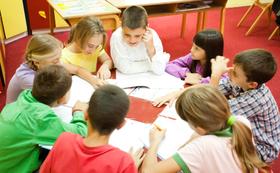Serving 164 students in grades 6-8, Harleyville-ridgeville Middle School ranks in the bottom 50% of all schools in South Carolina for overall test scores (math proficiency is bottom 50%, and reading proficiency is bottom 50%).
The percentage of students achieving proficiency in math was 6-9% (which was lower than the South Carolina state average of 43%). The percentage of students achieving proficiency in reading/language arts was 25% (which was lower than the South Carolina state average of 52%).
The student-teacher ratio of 9:1 was lower than the South Carolina state level of 14:1.
Minority enrollment was 73% of the student body (majority Black), which was higher than the South Carolina state average of 53% (majority Black).
Top Rankings
Harleyville-ridgeville Middle School ranks among the top 20% of public schools in South Carolina for:
Category
Attribute
Percent Eligible For Free Lunch
Community Size
Student Attention
School Overview
Grades Offered
Grades 6-8
(Supplemental Virtual)
(Supplemental Virtual)
Total Students
164 students
Gender %
Total Classroom Teachers
19 teachers
School Rankings
Overall Testing Rank
#1081 out of 1118 schools
(Bottom 50%)
(Bottom 50%)
Math Test Scores (% Proficient)
6-9%
43%
Reading/Language Arts Test Scores (% Proficient)
25%
52%
Science Test Scores (% Proficient)
20-24%
50%
Student-Teacher Ratio
9:1
14:1
American Indian
3%
n/a
Asian
n/a
2%
Hispanic
8%
14%
Black
59%
31%
White
27%
47%
Hawaiian
n/a
n/a
Two or more races
3%
6%
All Ethnic Groups
Participates in the National School Lunch Program (NSLP)
Yes
Eligible for Free Lunch
100%
67%
Eligible for Reduced Lunch (13-14)
9%
6%
School Statewide Testing
School District Name
Source: National Center for Education Statistics (NCES), SC Dept. of Education
Profile last updated: 02/09/2025
Frequently Asked Questions
What is Harleyville-ridgeville Middle School's ranking?
Harleyville-ridgeville Middle School is ranked #1081 out of 1,118 schools, which ranks it among the bottom 50% of public schools in South Carolina.
What percent of students have achieved state testing proficiency in math and reading?
6-9% of students have achieved math proficiency (compared to the 43% SC state average), while 25% of students have achieved reading proficiency (compared to the 52% SC state average).
How many students attend Harleyville-ridgeville Middle School?
164 students attend Harleyville-ridgeville Middle School.
What is the racial composition of the student body?
59% of Harleyville-ridgeville Middle School students are Black, 27% of students are White, 8% of students are Hispanic, 3% of students are American Indian, and 3% of students are Two or more races.
What is the student-teacher ratio of Harleyville-ridgeville Middle School?
Harleyville-ridgeville Middle School has a student ration of 9:1, which is lower than the South Carolina state average of 14:1.
What grades does Harleyville-ridgeville Middle School offer ?
Harleyville-ridgeville Middle School offers enrollment in grades 6-8 (Supplemental Virtual).
What school district is Harleyville-ridgeville Middle School part of?
Harleyville-ridgeville Middle School is part of Dorchester 04 School District.
Recent Articles

Charter Schools vs Public Schools 2025: Key Differences & Trends
Explore updated 2025 insights comparing charter schools vs public schools, enrollment, academic outcomes, funding, and real-world examples for families and educators.

Are Public Schools Ready for the 21st Century? 2025 Update
Explore 2025 insights on whether public schools are ready for the 21st century, covering performance, technology, equity, funding, and future-ready learning.

Public School Open House & Enrollment Season Guide
A parent-focused guide to the public school open house and enrollment season, with expert questions, timelines, and decision tips.





